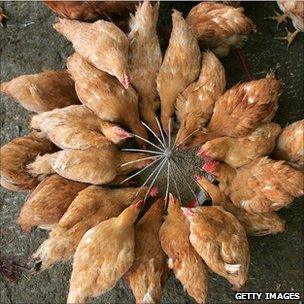Chicken feathers suggested as basis for plastics
- Published

The millions of tonnes of chicken feathers discarded each year could be used in plastics, researchers say.
A study reported at the American Chemical Society meeting in the US suggests feathers could lead to more environment-friendly, lighter plastics.
The chemical recipe requires significantly less petroleum-derived material.
However, tests on a grander scale will be necessary to establish the idea's industrial feasibility.
Such "biowaste" materials have been proposed as components of plastic formulations before.
Feathers, like hair and fingernails, are made up principally of the tough and chemically stable protein keratin, and can lend strength while reducing weight in the mixtures of plastics chemicals known as composites.
Researchers at the US agricultural authority have even published research into the possibility of incorporating chicken feathers into plastics, as an additive in composites that are made largely of a chemical polymer.
But the work presented by Yiqi Yang, from the University of Nebraska, Lincoln, takes this idea further and uses the chicken feather fibres themselves as a principal ingredient - making up 50% of the mass of the composite.
As a result, the plastics require less of the materials such as polyethylene and polypropylene that are derived from petroleum products.
"[Prior] technology uses keratin as an 'additive' to polyethylene and polypropylene. Our work turns feathers into something like polyethylene and polypropylene," Professor Yang told BBC News.
"If used as composite materials, no polyethylene or polypropylene are needed. Therefore [the plastics] will be more degradable and more sustainable."
Professor Yang's team processed chicken feathers and added a chemical known as methyl acrylate to turn them into a plastic, from which they made thin films.
These films were tougher than comparable formulations using other biowaste materials, and Professor Yang said that a crucial advantage of the team's approach was that their plastics are much more resistant to water.
Renko Akkerman, technical director of the Thermoplastic Composite Research Centre in the Netherlands, said that, depending on the application, feather-derived composites could be a strong addition to the palette of plastics.
"Whenever you can use waste for a functional product, I'd say that's a good idea. So using biomaterials, whether it's for commodity products or even structural applications, that's worth pursuing," he told BBC News.
However, he said that only by making larger amounts of the composite - and assessing the energy costs of production - could a full assessment of the idea be made.
"For each material you can do things at a very minor scale, but making the transition to mass production is a large one and only then can you truly grade the performance in terms of economics, carbon footprint, and so on.
"Despite all that we should pursue things like these, try and use biomaterials - certainly if it's waste otherwise - and make something useful."
- Published20 June 2008
- Published15 September 2008
- Published16 July 2006